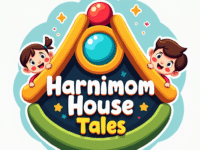
Teaching Toddlers to Say “I Need Help”
Gentle Ways to Raise Emotionally Aware and Independent Little Humans
By Harnimom — Toddler Storybook Author & Gentle Parenting Creator
“I DO IT!” … then comes the frustrated wail

Your toddler is halfway up the chair, spaghetti sauce everywhere, the tower has toppled, and suddenly—there’s a meltdown.
Sound familiar?
Most toddlers struggle to say one simple but powerful phrase:
“I need help.”
It’s not that they don’t need help. It’s that asking feels big, scary, vulnerable… or totally unfamiliar. Independence is exciting for toddlers—but it can also be overwhelming. The expectation to “do it all” without assistance can lead to frustration, tears, or even tantrums.
But the good news is—this is a teachable skill.
And one of the most powerful parenting gifts you can give is showing your child how to ask for help with confidence and calm.
Why Toddlers Don’t Naturally Say “I Need Help”
Between ages 1–3, toddlers are still developing emotional regulation, language and communication, trust in adults as calm, safe helpers, and confidence in trying versus giving up. The brain of a toddler is still learning to process challenge and communication at the same time.
When something is hard, they often default to:
- Screaming
- Throwing
- Whining
- Refusing entirely
It’s not defiance. It’s overwhelm. It’s a response to frustration mixed with an inability to articulate what’s wrong. Many toddlers would ask for help—if they had the words, if they weren’t afraid to be corrected, or if they simply remembered it was an option.
That’s why you are so important. You help wire their responses.
The Goal: Empowered Asking, Not Just Quiet Compliance
In gentle parenting, we don’t want silent children who do what they’re told. We want connected kids who:
- Recognize their limits
- Trust their caregivers
- Know it’s safe to speak up
- Feel proud, not ashamed, when they need support
When a toddler says “I need help,” they’re practicing self-awareness, emotional regulation, and problem-solving all at once. That’s powerful stuff. And it should be celebrated.
Step-by-Step: How to Teach “I Need Help”
1. Model the Phrase Daily
Even if your child isn’t speaking yet, narrate your own struggles out loud. This creates a natural association between needing help and speaking up.
Examples:
- “Oh no, I dropped my spoon. I need help picking it up.”
- “I can’t open this jar. I’ll ask Daddy for help.”
- “This zipper is stuck. I need help to fix it.”
Hearing that help-seeking is normal helps normalize it.
2. Introduce the Phrase with a Storybook
Storybooks show characters facing problems—and asking for help in age-appropriate, emotionally safe ways.
Storybook Suggestion:
Honey Who Roared With Courage
Honey the bear feels overwhelmed when something big and scary happens. But with a few deep breaths and help from friends, she learns that real bravery means asking for help—even when you’re scared.
After reading, say:
“Honey asked for help and that was so brave! Have you ever needed help like Honey?”
Extend this by acting out a part of the story, or asking your child to draw what help looked like for Honey.
3. Use Simple, Clear Words
Avoid long explanations or too many options. Keep it short and repeatable. Language like “help please” or “I need help” is powerful, but only if toddlers hear it often and in a calm tone.
Try:
- “Say: help please.”
- “Let’s ask for help.”
- “You can say: I need help.”
If they sign or gesture—model the verbal version alongside.
4. Celebrate the Ask, Not Just the Outcome
Whether they say “hep!” or gesture with a whimper—celebrate the try. You’re building a connection that says, “It’s okay to need me.”
Say things like:
- “You asked for help! That was amazing.”
- “I love when you tell me what you need.”
- “You are learning to use your words. That’s brave.”
5. Use Visual Reminders or Prompts
Toddlers are visual learners. Add visual cue cards near high-frustration zones (like toy shelves or puzzles).
Create a feelings board with photos showing:
“I try” → “I feel stuck” → “I ask for help”
You can also make a small poster with a child’s photo and speech bubble: “I need help!”
6. Practice Through Play
Use puppets, dolls, or pretend play to act out asking for help. Role-playing creates muscle memory without pressure.
Example:
- The teddy bear drops his spoon
- Your toddler helps or says, “He can ask for help!”
- You model it together
Later, during real-life frustrations, reference the game: “Remember what teddy did when he needed help?”
7. Stay Calm When They Don’t Ask
Even if your toddler is screaming instead of asking, you can still model the language.
“You’re upset. I think you needed help. Next time, you can say, ‘Help please.’ I’ll always listen.”
No scolding. No shame. Just calm teaching. This keeps the learning space safe.
8. Be Patient—This is a Skill
Like learning to walk, asking for help takes time, repetition, and positive reinforcement.
Some toddlers will blurt it out by 18 months. Others won’t master it until closer to 3. That’s okay.
Every small win counts. If they tap your leg instead of screaming, that’s progress. If they say “eh” instead of wailing, that’s growth. Be their calm coach.
Everyday Moments to Practice Asking for Help
Here are some places where you can gently teach and encourage asking:
Scenario – What to Say
Can’t open a snack pack – “Say: Help, please!”
Trying to put on socks – “Let’s ask: I need help”
Puzzle frustration – “That’s hard. Ask me.”
Stuck in a shirt – “You’re stuck. Need help?”
Want a toy out of reach – “Try saying: Help please.”
You can also use photos of your toddler doing these things, and point to them during the moment.
Books That Help Toddlers Ask for Help
Here are toddler-friendly books from the Harnimom collection that encourage communication, asking, and emotional expression:
- Honey Who Roared With Courage – Bravery and help-seeking
- Milo Feels Mad – Emotional overwhelm and calming strategies
- The Sharing Sunflower – Sharing And Caring
- Toby Learns To Pause – Learning when to Pause
- Zara Counts To Calm – Pausing, asking, and managing big feelings
Bundle all 5 in our Emotional Growth Collection available on Harnimom.com
From One Parent to Another
There’s no magic phrase that fixes every meltdown. But each time your toddler asks for help—even in a whisper, even with tears in their eyes—it’s a win. A win for communication, connection, and future emotional strength.
You’re not spoiling them. You’re showing them that needing help is human. And that love doesn’t go away when things are hard.
You’ve got this. And we’re here to help—with stories that make it easier.
Want More Gentle Toddler Tips?
Find free printables, storybook bundles, and toddler parenting tools at Harnimom.com. Sign up for our newsletter and follow along on Instagram for daily encouragement.













